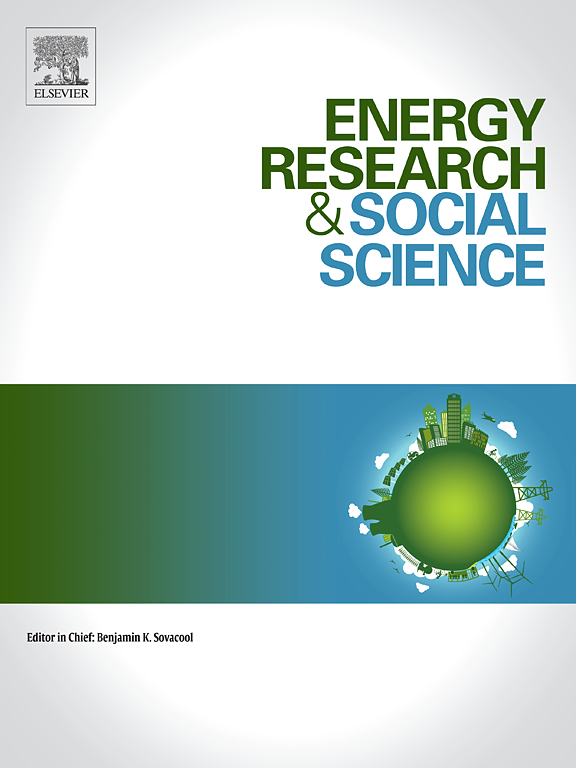绘制美国家庭能源脆弱性:来自统计和机器学习分析的新见解
IF 7.4
2区 经济学
Q1 ENVIRONMENTAL STUDIES
引用次数: 0
摘要
我们采用了一个两阶段的理论驱动框架,利用2020年住宅能源消耗调查来诊断美国家庭能源脆弱性。第一步使用带有协变量的潜在类分析,在一个单一的、一致的可能性框架中提取三个基于能力的概要文件——安全的、成本压力的和脆弱的。第二步采用SHapley加性解释(SHAP)解释的LightGBM模型,对每个剖面背后的潜在驱动因素进行排序。年收入5万美元、居住在绝缘较差的单户住宅中、并受到高地区能源价格影响的家庭最有可能落入脆弱阶层。对于较大的黑人和女性户主家庭以及居住在高供暖或制冷日负荷气候中的家庭,风险加剧。成本压力大的阶层主要受大建筑面积、“其他租赁”使用权和中等收入(50,000美元至74,999美元)的驱动;绝缘不足和就业不安全进一步加剧了风险。这些发现揭示了美国能源困难的异质性,并确定了政策的不同杠杆点。将这种差异化战略纳入联邦和州的能源正义倡议中,可以更公平地减少家庭能源负担,并在人口和地区范围内提高基于能力的福祉。本文章由计算机程序翻译,如有差异,请以英文原文为准。
Mapping household energy vulnerabilities in the United States: New insights from statistical and machine learning analyses
We deploy a two-stage, theory-driven framework to diagnose household energy vulnerability in the United States using the 2020 Residential Energy Consumption Survey. The first step employs a Latent Class Analysis with covariates to extract three capability-based profiles—Secured, Cost-Stressed, and Vulnerable—within a single, coherent likelihood framework. The second step fits a LightGBM model interpreted through SHapley Additive exPlanations (SHAP) to rank the underlying drivers behind each profile. Households earning < $50,000, living in poorly insulated single-family homes, and exposed to high regional energy prices are most likely to fall into the Vulnerable class. The risk intensifies for larger, Black, and female-headed households and for those residing in climates with high heating or cooling degree-day loads. The Cost-Stressed class is driven mainly by large floor area, “other rental” tenure, and moderate incomes ($50,000–$74,999); inadequate insulation and employment insecurity further elevate risk. These findings expose the heterogeneity of U.S. energy hardship and identify distinct leverage points for policy. Embedding such differentiated strategies within federal and state energy-justice initiatives can more equitably reduce household energy burdens and advance capability-based well-being across demographic and regional lines.
求助全文
通过发布文献求助,成功后即可免费获取论文全文。
去求助
来源期刊

Energy Research & Social Science
ENVIRONMENTAL STUDIES-
CiteScore
14.00
自引率
16.40%
发文量
441
审稿时长
55 days
期刊介绍:
Energy Research & Social Science (ERSS) is a peer-reviewed international journal that publishes original research and review articles examining the relationship between energy systems and society. ERSS covers a range of topics revolving around the intersection of energy technologies, fuels, and resources on one side and social processes and influences - including communities of energy users, people affected by energy production, social institutions, customs, traditions, behaviors, and policies - on the other. Put another way, ERSS investigates the social system surrounding energy technology and hardware. ERSS is relevant for energy practitioners, researchers interested in the social aspects of energy production or use, and policymakers.
Energy Research & Social Science (ERSS) provides an interdisciplinary forum to discuss how social and technical issues related to energy production and consumption interact. Energy production, distribution, and consumption all have both technical and human components, and the latter involves the human causes and consequences of energy-related activities and processes as well as social structures that shape how people interact with energy systems. Energy analysis, therefore, needs to look beyond the dimensions of technology and economics to include these social and human elements.
 求助内容:
求助内容: 应助结果提醒方式:
应助结果提醒方式:


